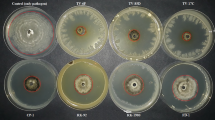Abstract
Bacillus subtilis AH18 and B. licheniformis K11 are multi-functional plant growth-promoting rhizobacteria (PGPR) that promote growth of red peppers and suppress phytophtora blight caused by Phytophtora capsici. A formulation of the two Bacillus strains was developed by producing heat-shocked endospores that had increased heat resistance. For large-scale cultivation in an 8-L jar fermentor, optimal culture conditions were pH 6.8, fermentation temperature of 30, and agitation speed of 180 rpm, with antifoaming agents added at a ventilation condition of 0.8 vvm. Induction of vegetative growth was achieved using 5.0×10-6 M dipicolinic acid and 7.0×10-4 M CaCl2. The subsequent large-scale cultivation produced viable cell numbers of 109 colony forming units/mL. High and low temperature stability tests of pilot products subjected to extreme storage conditions in accordance with thermal stability test standards revealed that storage for up to three years was possible without adverse effects. The combined use of two Bacillus microbial agents in vivo synergistically suppressed phytophthora blight, even following storage of the bacterial formulation at 54°C for 6 weeks. In field tests involving a phytophthora blight outbreak in red pepper, 40% of untreated peppers died, whereas 80% of peppers treated with the bacterial formulation survived for 65 days. The results indicate the potential of the B. subtilis AH18 and B. licheniformis K11 co-treatment for organic pepper farming.
Similar content being viewed by others
References
Chung S, Lim HM, and Kim SD (2007) Formulation of stable Bacillus subtilis AH18 against temperature fluctuation with highly heat-resistant endospores and micropore inorganic carriers. Appl Microbiol Biotechnol 76, 217–224.
Compant S, Duffy B, Nowak J, Clement C, and Barka EA (2005) Use of plant growth-promoting bacteria for biocontrol of plant disease: principles, mechanisms of action, and future prospects. Appl Envirom Mirobiol 71, 4951–5959.
Demoz BT and Korsten L (2006) Bacillus subtilis attachment, colonization, and survival on avocado flowers and its mode of action on stem-end rot pathogens. Biol Control 37, 68–74.
Hall JA, Peirson D, Ghosh S, and Glick BR (1996) Root elongation in various agronomic crops by the plant growth promoting rhizobacterium Pseudomonas putida GR12-2. Isr J Plant Sci 44, 37–42.
Jang JW and Kim SD (1995) Seed coating for the application of biocontrol agent Bacillus subtilis YBL-7 against phytopathogens. Kor J Microbiol Biotechnol 23, 243–248.
Jung HK, Kim JR, Woo SM, and Kim SD (2006) An auxin producing plant growth promoting rhizobacterium Bacillus subtilis AH18 which has siderophore-producing biocontrol activity. Kor J Microbiol Biotechnol 34, 94–100.
Jung HK, Kim JR, Woo SM, and Kim SD (2007) Selection of the auxin, siderophore, and cellulose-producing PGPR, Bacillus licheniformis K11 and its plant growth promoting mechanism. J Korean Soc Appl Biol Chem 50, 23–28.
Kim HJ, Lee SH, Kim CH, Lim EK, Choi KH, Kong HG, Kim DW, Lee SW and Moon BJ (2007) Biological control of strawberry gray mold caused by Botrytis cinerea using Bacillus licheniformis N1 formulation. J Microbiol Biotechnol 17, 438–444.
Kloepper JW, Lifshitz R, and Zablotowicz RM (1989) Freeliving bacterial inocula for enhancing crop productivity. Trends Biotechnol 7, 39–43.
Kloepper JW, Ryu CM, and Zhang S (2004) Induced systemic resistance and promotion of plant growth by Bacillus spp. Phytopathol ogy 94, 1259–1266.
Kwon DH, Choi JH, Jung HK, Lim JH, Joo GJ, and Kim SD (2004) Selection and identification of Auxin-producing plant growth promoting rhizobacteria having phytophathogen antagonistic activity. J Korean Soc Appl Biol Chem 47, 17–21.
Lee ET and Kim SD (1999) Isolation and antifungal activity of the chitinase producing bacterium Serratia sp. 3095 as antagonistic bacterium against Fusarium sp. J Korean Soc Agric Chem Biotechnol 42, 181–187.
Lee ET, Lim SK, Nam DH, Khang YH, and Kim SD (2003) Pyoverdin2112 of Pseudomonas fluorescens 2112 inhibits Phytophthora capsici, a red- pepper blight-causing fungus. J Microbiol Biotechnol 13, 415–421.
Lee JP, Lee SW, Kim CS, Son JH, Song JH, Lee KY, Kim HJ, Jung SJ, and Moon BJ (2006) Evaluation of formulations of Bacillus licheniformis for the biological control of tomato gray mold caused by Botrytis cinerea. Biol Control 37, 329–337.
Lim JH, Jung HY, and Kim SD (2009) Development of the microbial consortium for the environmental friendly agriculture by the antagonistic rhizobacteria. J Appl Biol Chem 52, 116–120.
Lim JH and Kim SD (2009) Synergistic plant growth promotion by the indigenous auxin-producing PGPR Bacillus subtilis AH18 and Bacillus licheniformis K11. J Korean Soc Appl Biol Chem 52, 231–538.
Liu L, Kloepper JW, and Tuzun S (1995) Induction of systemic resistance in cucumber by plant growth-promoting rhizobacteria: duration of protection and effect of host resistance on protection and root colonization. Phytopathology 85, 1064–1068.
Raupach GS and Kloepper JW (1998) Mixtures of plant growth-promoting rhizobacteria enhance biological control of multiple cucumber pathogens. Phytopathology 88, 1158–1164.
Woo SM, Jung HK, and Kim SD (2006) Cloning and characterization of a cellulase gene from a plant growth promoting rhizobacterium, Bacillus subtilis AH18 against Phytophthora blight disease in red-pepper. Korean J Microbiol Biotechnol 34, 311–317.
Woo SM and Kim SD (2008) Structural identification of siderophoreAH18 from Bacillus subtilis AH18, a biocontrol agent of Phytophthora blight disease in red-pepper. Korean J Microbiol Biotechnol 36, 326–335.
Wang Z, Langston DB, Csinos AS, Gitaitis RD, Walcott RR, and Ji P (2009) Development of an improved isolation approach and simple sequence repeat markers to characterize Phytophthora capsici populations in irrigation ponds in Southern Georgia. Appl Environ Microbiol 75, 5467–5473.
Yao AV, Bochow H, Karimov S, Boturov U, Sanginboy S, and Sharipov AK (2006) Effect of FZB24® Bacillus subtilis as a biofertilizer on cotton yields in field tests. Arch Phytopathol Plant Prot 39, 1–6.
Author information
Authors and Affiliations
Corresponding author
Rights and permissions
About this article
Cite this article
Lim, JH., Kim, SD. Biocontrol of phytophthora blight of red pepper caused by Phytophthora capsici using Bacillus subtilis AH18 and B. licheniformis K11 formulations. J. Korean Soc. Appl. Biol. Chem. 53, 766–773 (2010). https://doi.org/10.3839/jksabc.2010.116
Received:
Accepted:
Issue Date:
DOI: https://doi.org/10.3839/jksabc.2010.116



